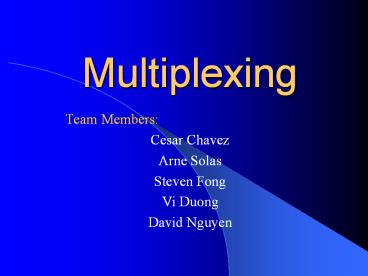Multiplexing - PowerPoint PPT Presentation
1 / 27
Title:
Multiplexing
Description:
Protocol used for reliable document transfer ... UDP is the alternative to TCP. ... are also available from companies like IBM, Oracle, SGI, Sun and Tektronix. ... – PowerPoint PPT presentation
Number of Views:41
Avg rating:3.0/5.0
Title: Multiplexing
1
Multiplexing
- Team Members
- Cesar Chavez
- Arne Solas
- Steven Fong
- Vi Duong
- David Nguyen
2
Streaming Protocols
3
TCP Transmission Control Protocol
- Protocol used for reliable document transfer
- HTTP (Hypertext Transfer Protocol) uses TCP as
the protocol for reliable document transfer. - Unsuitable for video and audio because
- Imposes flow control
- Unnecessary Message delivery
4
UDP User Datagram Protocol
- UDP is the alternative to TCP.
- UDP forsakes TCP's error correction and allows
packets to drop out if they're late or damaged. - Access Problems (firewalls).
5
RTP
- The data part of RTP is a thin protocol providing
support for applications with real-time
properties. - continuous media (timing reconstruction )
- loss detection
- security
- content identification.
6
VDP
- VDP is an augmented RTP with demand resend.
- VDP creates two channels between the client and
server. - One is a control channel.
- The other channel is for the streaming data.
7
RTSP
- . RTSP is a communications protocol for control
and delivery of real-time media. - It defines the connection between streaming
media client and server software - Provides a standard way for clients and servers
from multiple vendors to stream multimedia
content.
8
RSVP
- Protocol designed to allow the assignment of
priorities to "streaming" applications. - Works by permitting an application transmitting
data over a routed network to request and receive
a given level of bandwidth.
9
Media Streaming
- Comparison of Commercial Video Streaming Products
- Commercial Video Servers
- Research on Continuous Media Toolkits and QoS
Architectures
10
Comparison of Commercial Video Streaming Products
- Deliver highest quality video for a given
bandwidth, lowest delay, no jitter(low frame
loss), good audio/visual synchronization, high
quality audio, and image resolution. - Best possible video quality over a range of
networks/bandwidths without content duplication
is highly desirable. This characteristic is
referred to as scalability. - Commercial products offer two types of
scalability.
11
Continued
- One is the encoding state. A range of encoding
formats to choose from, which correspond to a
range of bandwidths. - Two is the dynamic scalability based on the
available bandwidth at the time. Where dynamic
scalability is provided it is usually simple
frame dropping.
12
Commercial Video Servers
- High-end database-driven video servers are also
available from companies like IBM, Oracle, SGI,
Sun and Tektronix. These products should be
considered for large scale applications or for
serving large numbers of simultaneous stream.
13
Research on Continuous Media Toolkits and QoS
Architectures
- The following are the major research project
investigating the use of scalable video
compression to dynamically adapt to variable
bandwidth, to ensure multimedia delivery. - Berkeley Continuous Media Toolkit
- Application Level Gateway
- Distributed Real-time MPEG Video Audio Player
- Multimedia Communication Filters
- Image and Advanced TV Lab, Columbia
- DSTC SuperNova
14
Video Streaming Standards
- H.261
- H.263
- MPEG1
- MPEG2
- MPEG4
15
H.261
- H.261 is use for teleconferencing applications
and is intended for carrying video over ISDN. - H.261 needs substantially less CPU power for
real-time encoding than MPEG. - H.261 uses constant-bit-rate encoding.
16
H.263
- H.263 is design for low bitrate communication.
- H.263 expected to be use for wide range of
bitrate and expected to replace H.261. - H.263 supports 5 resolutions, able to compete
with MPEG standards.
17
MPEG-1
- MPEG-1 offers VHS quality video at a bandwidth of
1-1.5Mbps. - The resolution id at 30 frames per second
- MPEG-1 requires expensive hardware for real-time
encoding. - MPEG-1 does not offer resolution scalability
- MPEG-1 is not suitable for video conferencing
18
MPEG-2
- MPEG-2 is a better standard than MPEG-1
- MPEG-2 include support for higher resolution
video and increased audio capabilities. - MPEG-2 offers broadcast quality and full screen
video at a bandwidth of 4-18Mbps. - More expensive than MPEG-1 to encode and decode.
19
MPEG-4
- MPEG-4 is still in its experimental stage
- Compression scheme for video conferencing ,
- MPEG-4 can be use for multiplexing for
transmission over different networks - MPEG-4 framework focuses on a language called MSDL
20
Movie Maker by Sony
21
(No Transcript)
22
(No Transcript)
23
(No Transcript)
24
(No Transcript)
25
(No Transcript)
26
(No Transcript)
27
(No Transcript)































